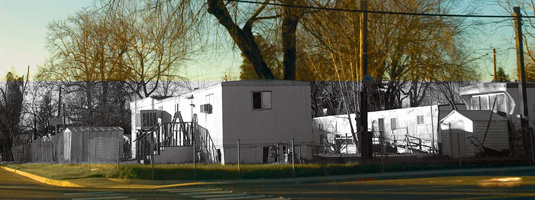
The Poor Get Poorer
Since 2001, the U.S. economy has been growing and the standard of living going up, but more than 4 million more Americans have slipped into poverty. Three UC Davis economists recently took a closer look at the reasons why and found the answer lies largely in a growing wage gap.
“One reason why it’s hard to make progress against poverty is that, even when poor people are working, their earnings are eroding over time,” said Ann Huff Stevens, associate professor of economics. “Wages haven’t grown for people at the bottom as fast as the whole economy has grown.”
Analyzing census data from 1967 through 2003, Stevens, Associate Professor Marianne Page and Professor Hilary Hoynes found that stagnant wages for the poorest fifth of working Americans explained poverty rates better than did unemployment rates, immigration, changing family structure and changes in government anti-poverty programs.
Their study also found that education, more than ever, is linked to economic well-being. “The wage growth associated with higher levels of education is much greater than it used to be,” Page said.
While the percentage of women who work increased, as did their average pay and education levels, the number of single-parent families also went up. “As more families split apart, the average income of any one of them is going to decrease,” Page said. “So what we’re finding, in part, is that those two trends are offsetting each other in terms of the bottom-line impact on poverty rates.”
Welfare-to-work reforms passed by Congress a decade ago have put more people to work in low-wage jobs but have done little to raise them out of poverty.
The federal minimum wage has been $5.15 an hour for nine years. Gov. Arnold Schwarzenegger has proposed raising California’s hourly minimum wage from $6.75 an hour to $7.75 an hour by the middle of next year—a proposal that some say doesn’t go far enough but business owners say could lead to layoffs.
How many low-wage employees work their way up the income ladder is unclear.
Job-training programs, at least in California, have had mixed results in getting low-skill workers into career-track positions, says David Campbell, a UC Davis Cooperative Extension specialist who has been evaluating welfare and job-training reforms in several counties.
“Even when you do everything right—whether you’re a participant in these programs or an agency—you feel like you’re on a treadmill going too fast,” Campbell said. “It’s hard to keep up with the economic realities out there.”
The federal Workforce Investment Act, passed in 1998 as a companion measure to welfare reforms, allowed local governments to work with private and nonprofit groups and to consider business’ hiring needs in creating job-training programs. In California, 50 local boards oversee the job-training efforts.
Campbell said some of the more successful programs in Sacramento and Los Angeles have worked with labor unions in placing and mentoring workers. However, he said, many programs find it hard to balance the hiring needs of local businesses with the training needs of hard-to-employ workers such as high-school dropouts, former prisoners and the homeless.
And with a 25 percent cut in federal funding for job training in California over the past five years, even successful programs have been eliminated or threatened. “You still have to provide enough money to get the job done,” Campbell said. “Moving people from welfare to work takes a lot of one-on-one attention.”
A budget-cutting bill passed by Congress in February further reduced funds for job training programs and imposed tougher work requirements for welfare recipients, as well as reducing health programs for the poor, disabled and elderly and raising interest rates for student loans.
Campbell’s team has found that the better the coordination among public and nonprofit agencies, the better the job-training programs. But he said government oversight remains key. “There are some people who would argue, let’s shrink the federal budget and let charities take over. If it’s public dollars, there has to be public accountability.”
Meanwhile, the fastest-growing types of jobs are the lowest paying, Campbell said. “We seem to be unique as a society in having the idea that the market will just take care of everything. That’s never been true, and it’s certainly not true now.”
The United States spends far less than other industrialized countries on social programs, even when noncash benefits—like food stamps, housing subsidies and Earned Income Tax Credit refunds—are taken into account. “Aid for poor people in the United States is at such a low level that’s it’s very unlikely to move people above the poverty line,” Hoynes said.
Related stories:
Homelesss—Poorest of the Poor
The homeless, says sociologist Dean MacCannell, are a lot like the rest of us—with dreams of a decent job, good home and a nice vacation. The difference is that “their relationship to the world is broken, usually by a drug or alcohol problem.” [more]
The New Rural Poor
Mention poverty and many people think of the inner cities. But a number of small Central Valley towns have poverty rates rivaling those found of the poorest neighborhoods of Los Angeles and Oakland. [more]
Students Help
Tu Tran Huynh was deeply touched by the homeless children she met as a high-school volunteer at Sacramento’s Loaves and Fishes dining hall. She wanted to do more to help, so as a sophomore at UC Davis she co-founded a student organization to advocate for the local poor. [more]
The Compassion Gap
Hurricane Katrina exposed more than the face of poverty in the United States, says sociologist Fred Block. It also revealed a historic schism in American attitudes—a “compassion gap” between traditions of helping and blaming the poor. [more]
Back to introduction, Poverty in the Land of Plenty,

Kathleen Holder is associate editor of UC Davis Magazine. Photos by Karin Higgins/UC Davis.
|

